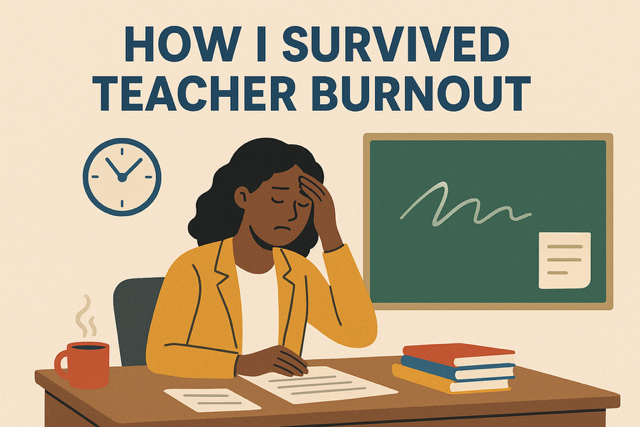
DISCOUNTED EDUCATION PRICING! CALL 1-877-891-8411. We Gladly Accept School Purchase Orders!

Teaching is one of the most fulfilling professions, but it comes with a hidden cost. The long hours, emotional investment, and constant pressure to perform can leave even the most passionate educators feeling drained, overwhelmed, and on the verge of burnout. I know because I’ve been there—staring at a pile of ungraded papers at 10 p.m., feeling like I was failing my students, my family, and myself. If you’re reading this and nodding along, know that you’re not alone, and more importantly, you don’t have to stay stuck in that exhausting cycle.
Burnout doesn’t mean you’re weak or that you’re not cut out for teaching. It’s a signal that something needs to change. After hitting rock bottom, I discovered seven simple habits that transformed my life and helped me rediscover the joy in teaching. These aren’t quick fixes or one-size-fits-all solutions, but they worked for me, and I believe they can work for you too. In this post, I’ll walk you through each habit, share practical tips, and offer resources to help you reclaim your energy, balance, and love for teaching.
Before diving into the habits, let’s talk about why teacher burnout is so common among teachers. The demands of the job—lesson planning, grading, parent meetings, extracurricular duties, and emotional labor—can pile up quickly. Add to that the societal expectation to be a superhero who inspires every student, and it’s no wonder we feel stretched thin. According to a 2023 study by the National Education Association, 55% of teachers reported feeling burned out, with many citing lack of work-life balance and insufficient support as key factors. Understanding this context helped me realize that burnout wasn’t a personal failure—it was a systemic challenge that required intentional strategies to overcome.
Teachers are notorious for saying “yes” to everything—extra tutoring sessions, last-minute committee roles, or covering a colleague’s class. While these acts of service are noble, they can erode your mental and physical health if left unchecked.
What worked for me: I started setting clear boundaries by evaluating requests against my core priorities: my health, my family, and my ability to teach effectively. For example, I politely declined non-essential after-school commitments and communicated my limits to my administration. Saying “no” felt uncomfortable at first, but it gave me back hours of my week and reduced my stress significantly.
Pro tip: Use a digital or physical calendar to block off personal time—whether it’s an evening with family or a quiet hour for yourself. Treat these blocks as sacred, non-negotiable appointments. If you’re worried about seeming uncooperative, practice saying, “I’d love to help, but my schedule is full right now. Can we explore another solution?”
Why it works: Boundaries protect your energy and allow you to show up as your best self for your students. Research shows that teachers who set clear work-life boundaries report lower stress levels and higher job satisfaction.
As teachers, we often feel guilty for taking time for ourselves. But self-care isn’t selfish—it’s a necessity. You can’t pour from an empty cup, and prioritizing “me time” ensures you have the energy to keep giving.
What worked for me: I carved out one hour each week for something that brought me pure joy, like reading a novel, practicing yoga, or even binge-watching a favorite show. At first, I felt guilty for not spending that time grading or planning, but I soon realized that this time made me a better teacher and a happier person.
Pro tip: Schedule “me time” in your calendar just like you would a staff meeting. Pick an activity that feels indulgent but doesn’t require much effort—think a walk in the park, a coffee date with yourself, or listening to a podcast. Start small if an hour feels daunting; even 15 minutes can make a difference.
Why it works: Regular self-care boosts resilience and reduces the risk of burnout. A 2022 study in the Journal of Educational Psychology found that teachers who engaged in regular self-care activities reported lower levels of emotional exhaustion.
One of the biggest traps for teachers is bringing work home—physically or mentally. Grading papers at midnight or ruminating over a tough classroom moment can blur the lines between work and life.
What worked for me: I created a clear end-of-day ritual to signal the transition from “teacher” to “me.” At 5 p.m., I turned off my computer, closed my classroom door, and left work behind. If I needed to stay late, I set a hard stop and stuck to it. This ritual helped me mentally disconnect and be present for my personal life.
Pro tip: Create your own ritual—something as simple as shutting down your email, tidying your desk, or listening to a favorite song on your commute home. Set a timer to remind yourself when it’s time to stop working, and honor it consistently. A teacher work-life balance is key.
Why it works: Rituals create psychological separation between work and home, reducing stress and improving sleep quality. Studies show that clear work-life boundaries enhance overall well-being.
Teaching can feel isolating, especially when you’re struggling. But you don’t have to face burnout alone. A strong support system can make all the difference.
What worked for me: I connected with a small group of colleagues who became my “tribe.” We met monthly for coffee or virtual chats to share challenges, swap lesson ideas, and lift each other up. These conversations reminded me that I wasn’t alone and gave me practical strategies to cope.
Pro tip: Find at least one colleague, mentor, or friend who gets it. If in-person meetups aren’t feasible, join an online teacher community on platforms like X or Reddit. Share one win and one challenge each week to build connection and accountability. Having parents involved can significantly help with preventing burnout.
Why it works: Social support reduces feelings of isolation and increases job satisfaction. A 2021 study found that teachers with strong professional networks were less likely to experience burnout.
Teaching can feel like a never-ending to-do list, with big goals like “improve student outcomes” looming large. But focusing on what you haven’t done can sap your motivation. Instead, celebrate the small wins.
What worked for me: I started keeping a “win journal” where I jotted down three positive moments from each day—whether it was a student’s “aha” moment, a successful lesson, or even just managing a tricky parent email. This habit shifted my focus from what went wrong to what went right.
Pro tip: At the end of each day, write down three small wins in a notebook or on your phone. They don’t have to be earth-shattering—just meaningful to you. Over time, this practice builds a sense of accomplishment and resilience.
Why it works: Focusing on positive moments boosts motivation and counters the negativity bias that fuels burnout. Positive psychology research supports the power of gratitude and reflection in improving mental health.
Nature has a remarkable ability to reset our minds, but it’s easy to forget this when you’re stuck in a classroom all day. Even a brief dose of fresh air can work wonders. Help stop teacher burnout before it happens.
What worked for me: I started taking short walks around my school during lunch or prep periods. On tough days, I’d sit outside with my coffee and just breathe. Those 10 minutes of quiet, away from screens and noise, recharged me more than I expected.
Pro tip: Set a daily reminder to step outside, even if it’s just to stand in the school courtyard. If you’re in a busy urban area, find a quiet corner or bring noise-canceling earbuds to create your own oasis.
Why it works: Exposure to nature reduces stress hormones and improves mood, according to a 2019 study in Scientific Reports. Even brief outdoor breaks can enhance focus and energy.
Teaching is a calling, but it’s not your entire identity. Nurturing other parts of yourself—your hobbies, passions, or curiosities—can reignite your spark and prevent burnout.
What worked for me: I signed up for an online photography course, something I’d always wanted to explore but never made time for. Spending a few hours a week on a creative outlet unrelated to teaching gave me a sense of purpose and joy that carried over into my classroom.
Pro tip: Pick one non-teaching-related activity to try, like learning a new skill, joining a book club, or starting a side hustle. It doesn’t have to be time-intensive—start with an hour a week and see where it takes you.
Why it works: Engaging in diverse activities fosters a sense of identity beyond work, which is critical for long-term well-being. Studies show that teachers who pursue personal interests report higher life satisfaction.
Teacher burnout is real, and it’s okay to admit you’re struggling. But it’s also possible to move from merely surviving to truly thriving. These seven habits aren’t about overhauling your life overnight—they’re about small, intentional changes that add up over time. Start with one or two that resonate with you, and build from there. Be patient with yourself, and remember that you’re not just a teacher—you’re a human being who deserves balance, joy, and fulfillment.
If these habits strike a chord, share this post with a fellow educator who might need a boost. Have your own strategies for beating teacher burnout? Drop them in the comments below—I’d love to hear what works for you. Let’s build a community of teachers who support each other to thrive, not just survive.
Seeking help is a sign of strength, not weakness. Here are some resources to support your mental health and well-being:
Teaching is hard, but you are stronger than you know. By taking small steps to prioritize your well-being, you’re not just helping yourself—you’re modeling resilience for your students and colleagues. You’ve got this, and we’re in this together.